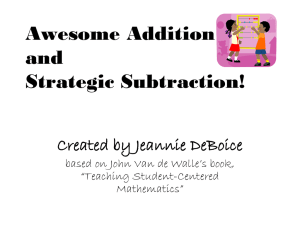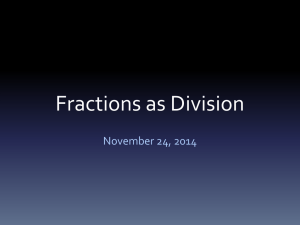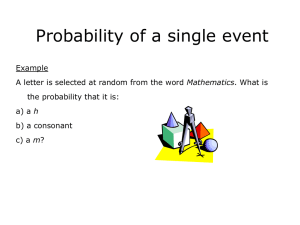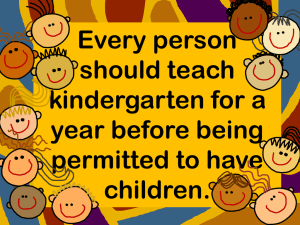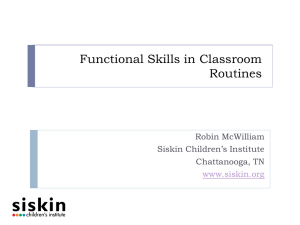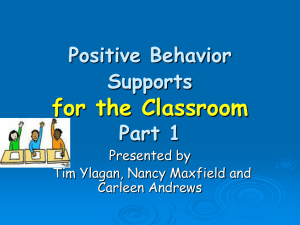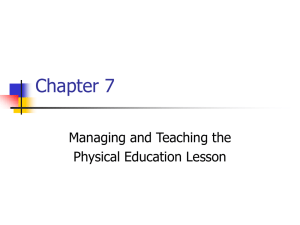Ten Frames PD - melrosecurriculum
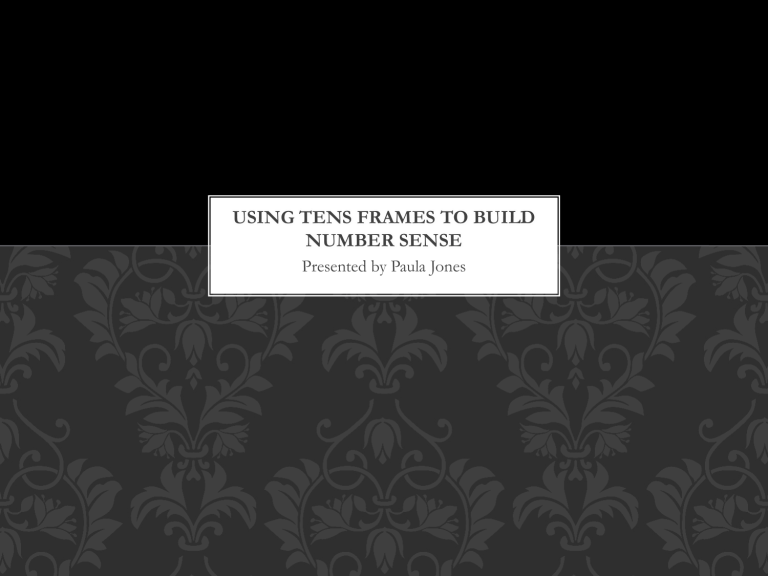
USING TENS FRAMES TO BUILD
NUMBER SENSE
Presented by Paula Jones
This is a ten-frame:
WHAT IS A TEN-FRAME?
A ten frame is a five-by-two array used to support the development of the important landmark numbers five and ten. It is mostly positioned horizontally and filled with counters placed from left to right and top to bottom. In lessons designed to help students visualize numbers, counters are randomly placed on the ten-frame.
WHAT IS A TEN-FRAME?
This is a double ten-frame:
A double ten-frame is two ten-frames used to support the development of the important landmark numbers ten and twenty. It is also designed to support addition strategies (such as making a ten) and place-value ideas (such as building fourteen using one ten-frame filled with ten counters and a second ten-frame filled with four counters.
These are ten-frame cards:
For our purposes, a complete set of ten-frame cards is four copies of this so when the cards are cut apart, each deck should have forty cards ranging from one dot to ten dots. Ten-frame cards are used during lessons and activities to develop fluency with addition facts.
WHY USE TEN-FRAMES?
Ten-frames are a model to help students efficiently gain and develop an understanding of addition and subtraction.
Supports the mathematical practice of using models and also the practice of the use of appropriate tools and could help students attend to precision.
TURN AND TALK
How comfortable are you with tenframes?
Do you currently use ten-frames in your classroom?
How do you use ten-frames in your classroom?
THREE CATEGORIES FOR USING
TEN-FRAMES
We will divide today into three categories:
Routines…short lessons that should be revisited several times a year in order to build students’ sense of number. (5-20 minutes)
Games…this will offer an engaging way for students to practice skills.
(10-30 minutes)
Problem-solving…these lessons require extended time where students are asked to think and reason in order to deepen their understanding of number. These lessons should be used when your students are very familiar and comfortable using ten-frames. (30 minutes plus)
MATERIALS
Here is a basic list of materials needed for the lessons we will talk about and I have given you a packet with two sets of these materials. One we will use today, and the other you can use to reproduce for your students.
1 ten-frame for each student
1 double ten-frame for each student
1 set of ten-frame cards for each pair of students.
1 demonstration ten-frame
20 counters per student
WHAT IS A ROUTINE?
Routines are short (5-20 minute) intentional mini-lessons that develop or foster new learning about number.
Mathematical routines give teachers an opportunity to revisit skills from the previous year or unit and gives students the opportunity to practice skills in an environment that values communication and problem solving.
Routines allow teachers to spend a small amount of time on skills that develop students’ number sense and basic computation without disrupting the flow of the structured curriculum.
WHY/WHEN/HOW OF ROUTINES
Why these routines?
They are outstanding at helping students develop a sense of number and the ability to compute efficiently.
Because you will revisit them throughout the year, they engage students in the gradual process needed to help them understand number and build basic fact fluency.
When should you teach with routines?
Traditionally, they are presented every day at the beginning of the math block. (Think Number Talk…)
You can, however use them to start or end the day or compensate for extra time throughout the day. (Think 15 minutes before or after lunch…)
WHY/WHEN/HOW OF ROUTINES
How do you decide on a routine?
Let your students drive the routines you focus on.
Observing students during a lesson can give you valuable information and can provide the knowledge you need to select a routine.
For example, if you notice students struggling with their addition facts for nine, you could spend time working on the Adding Nine routine we will discuss shortly.
If you notice students are struggling to recognize numbers when they roll a standard die, spend time on the Look, Quick! routine.
Use certain routines over time-not every day-until students demonstrate mastery.
ROUTINES USING TEN-FRAMES
Look, Quick!
Make the Number
Say the Two-Digit Number
Number Strings
Adding Nine
Sums of More Than Ten
LOOK, QUICK!
Overview
In this routine, the teacher shows students counters on a ten-frame and asks them to look for groupings they see without counting.
(Subitizing…the ability to glace at a group of objects and quickly see how many there are without counting them one by one.)
Time
5-10 minutes
Materials
Demonstration ten-frame
Counters, 10
LOOK, QUICK!
Key Questions:
How many counters do you see?
How did you know how many counters were on the ten-frame?
How do you see the counters on the ten-frame?
Here we go! Let’s Play!
MAKE THE NUMBER
Overview
In this routine, the teacher quickly shows students a ten-frame with counters. Using their own ten-frames and counters, students then build what they just saw in the same configuration. This routine combines the ability to subitize with spatial reasoning.
Time
5-15 minutes
Materials
Demonstration ten-frame
Ten-frames, 1 per student
Counters, 10 per student
Sheets of construction paper or file folders, 1 per pair of students.
MAKE THE NUMBER
Key Questions:
How many counters did you use?
What did you build first?
How did you know where to place the counters?
What did you see?
How did you see it?
Here we go! Let’s Play!
SAY THE TWO-DIGIT NUMBER
Overview:
In this routine, the teacher quickly shows students a two-digit number represented via ten-frame cards and then asks them to figure out the number (by determining the total number of dots displayed). You need to pay special attention to how students figure out the number. The routine develops students’ ability to see two-digit numbers as tens and ones (or leftovers). Use of the ten frame cards provides an opportunity to introduce formal place-value vocabulary. To extend learning, you give students the opportunity to work in pairs to build the two-digit number using their own sets of ten-frame cards.
Time:
20 minutes
Materials:
Demonstration ten-frame cards, 1 set and ten-frame card with ten dots
SAY THE TWO-DIGIT NUMBER
Key Questions:
How many dots did you see?
How did you see them?
Here we go! Let’s play with a partner!
NUMBER STRINGS
Overview:
In this two-part routine, the teacher shows students strings of three numbers using ten-frame cards and asks them to look for efficient ways add the numbers. Number strings give students the opportunities to think about using ten as a landmark for adding numbers as well as making and using doubles as an efficient addition strategy. Students gain a deeper experience by looking at the entire string to find numbers they can efficiently add instead of adding from left to right by rote.
Time:
Part 1: 10-20 minutes
Part 2: 10-20 minutes
Materials:
Demonstration ten-frame cards, 1 set
Ten-frame cards, 1 set per pair of students
Demonstration double ten-frame
Double ten-frame, 1 per students or pair of student
Snap cubes or counters, 20 per student
NUMBER STRINGS
Key Questions:
Which two numbers would you like to add first?
Which numbers are friendly to add? Why?
How can making a ten help you solve the problem?
How does knowing nine plus one help you solve nine plus two, and so on?
Here we go! Let’s Play!
ADDING NINE
Overview:
In this routine, students use number and relationships to look for patterns and connections between addends and sums when adding nine to other numbers. Students develop and apply the use of ten, a landmark number, to help them learn their addition facts for nine.
Time:
20 minutes
Materials:
A small assortment of store advertisements
Demonstration double ten-frame
Adding Nine recording sheet
Snap cubes or counters in two colors
ADDING NINE
Key Questions:
How can making a ten help you solve this problem?
What number sentence matches what we see?
What do you notice about the number sentences?
SUMS OF MORE THAN TEN
Overview:
This four part routine gives students opportunities to use and apply the strategy of making a ten to help them solve near-ten addition facts. In addition to developing basic fact fluency, the routine promotes the building of mental math skills through visualization of ten-frames and number sentences.
Time:
20 minutes per part*
*This routine tends to be most successful when you repeat parts one and two several times a week for a few months. The repeated experience about making a ten helps students use this strategy.
Materials:
Demonstration double ten-frame & double ten-frame per student or pair of students
Sums of More Than Ten recording sheet, 1 copy per student
Counters in two colors, 10 of each color for teacher and per student or pair of students.
SUMS OF MORE THAN TEN
Key Questions:
How does knowing a combination of ten help you solve the new problem?
How many counters do you see and how do you know?
GAMES USING TEN-FRAMES
Dot Card Memory
Numeral Memory
Computation Memory
More or Less
Make Five
Collect Ten
Bank It!
Double Bank It!
Race to 20
WHY/WHEN/HOW WITH GAMES
These games are outstanding at encouraging students to rely on strategy or thoughtful decisions.
The games offer students an opportunity to work with their peers, discuss math in the context of an enjoyable activity, and practice skills (both skills that are newly acquired and those that were taught previously in the year).
Once you have taken the time to introduce students to a particular game, played the game during math time, and had an opportunity to discuss the content and strategies, you can repeatedly use that game in centers.
Taking the time to establish the rules, routines, and procedures during the first 6 to 9 weeks of school is crucial.
Modeling how to play a math game is critical to the success they will have while playing it.
WHY/WHEN/HOW WITH GAMES
Have students sit on the floor around the perimeter of the rug of the whole-group area, and place the game materials in the center.
There is more to modeling a game than simply performing the instructions. It is important that students see how to behave while playing a game.
Emphasize the following behaviors when modeling: waiting patiently for your turn, appropriately passing game pieces to your partner, and winning or losing gracefully.
Using recording sheets can serve both as formative assessment and summative assessment. Model the use of the recording sheet for the students.
GAMES 1 AND 2
Overview:
Dot Card Memor y
In this game students will subitize to match quantities on dot cards to quantities on ten-frame cards.
Time:
20 minutes
Key Questions:
How can you figure out how many dots are on the card?
How did you see the arrangements of dots?
The two cards you turned over do not match. Which number is more? Which number is less?
The two cards you turned over match.
What number is one more than the cards you matched? One less?
Numeral Memor y
Overview:
In this memory game, students will gain valuable practice in matching numerals with the corresponding quantities. We are trying to get students to look for ways to group the dots to determine the total.
Time:
10 minutes
Key Questions:
What do you think the ten-frame card that matches the numeral card you turned over will look like?
How many squares will be empty on the ten-frame card?
What strategies do you have for remembering where cards are located?
The two cards you turned over do not match.
Which number is more? Which number is less?
The two cards you turned over match. What number is one more than the cards you matched?
One less?
GAMES 3 AND 4
Computation Memor y
Overview:
In this memory game, students practice basic addition and subtraction facts by matching number sentences (on computation cards) with a total (on tenframe cards). For students who have been introduced to written number sentences and are practicing basic facts.
Time:
10 minutes
Key Questions:
What number sentence would be equal to the quantity on this ten-frame card?
You turned over two computation cards. Which number sentence equals more? Less?
You found a match. What other number sentences would be equal to the quantity on the ten-frame card?
More or Less
Overview:
In this game, students use a ten-frame to develop an understanding of inclusion and informally gain opportunities to consider more than and less than ideas.
Time:
20-30 minutes
Key Questions:
Does the ten-frame need “more or less” counters?
How did you find the sum of the two dice?
How did you think about putting
“more or less” counters on the tenframe?
GAMES 5 AND 6
Make Five
Overview:
In this game, students try to pair up ten-frame cards to get a sum of five. Five is an important landmark number, especially at the younger grades.
Time:
20-30 minutes
Key Questions:
What two cards have a sum of five?
How do you know?
What card would partner with the cards you see to create a sum of five?
You are about to draw from the deck: what do you hope to draw?
Why?
Overview:
Collect Ten
In this game, students try to pair up ten-frame cards to get a sum of ten. Ten is a landmark number; by knowing combinations of ten, students can begin to construct relationships when solving other basic facts.
Time:
20 minutes
Key Questions:
How can you prove___ and ___ equal ten?
What do you hope to draw? Why?
What are you going to ask for?
Why?
GAMES 7 AND 8
Bank It!
Overview:
In this game, each student turns over a tenframe card and compares the number of dots with the dots on their partner’s card.
Being able to compare numbers is an important aspect of number sense. This game connects common language with mathematical language for comparing numbers.
Time:
20 minutes
Key Questions:
You turned over a _ and your partner turned over a _. What do you wish your partner had turned over?
Who has the greater number? How do you know?
Which sentence frame will you use to compare your cards?
Double Bank It!
Overview:
In this game, each student turns over two ten-frame cards, finds the sum of the numbers, and compares the sum of his or her cards with the sum of the partner’s cards. It is essential that students have opportunities to make comparison statements about two equations.
Time:
20 minutes
Key Questions:
What is the sum of your two cards?
How did you figure it out?
Which sum is greater? How do you know?
GAME 9
Race to 20
Overview:
In this game, students roll a die and place that number of counters on a double ten-frame in an effort to reach 20 first. This game builds students’ understanding of landmark numbers, specifically ten and twenty. Through the use two colors of counters, students decompose the number twenty and use number strings to compose twenty.
Time:
20 minutes
Key Questions:
How many more counters do you need to have ten?
How many more counters do you need to have twenty?
How many more counters do you have compared with your partner?
How would you add the counters you have so far?
YOUR TURN!
Think about the following when selecting a game to try with a partner…
1.
What topic are you covering in EnVision?
2.
Which game would support that topic?
3.
Which game would be a good review of a previously taught skill?
4.
Where do your students have gaps and what game(s) would help backfill that gap?
5.
Where do your students need more practice?
Time to play!
PROBLEM-SOLVING USING
TEN-FRAMES
Two-Color Counters
Riddles
Mystery Sums
Adding and Subtracting Ten
Partial Sums
WHY/HOW/WHAT WITH
PROBLEM-SOLVING
These lessons are designed to engage students in solving a problem while using a ten-frame.
Some of the lessons are structured to follow a lesson plan format divided into three parts: introduction, exploration, and summary.
Introduction: The purpose is to familiarize students with the problem and to connect with students’ prior knowledge. This may mean solving a smaller problem or beginning to solve the problem students will work on in the exploration stage.
Exploration: The purpose is to give students opportunities to discover, deepen, and extend their understanding of number.
Summary: The purpose is to cement students’ learning and allow students to communicate their thinking about the problem.
WHY/HOW/WHAT WITH
PROBLEM-SOLVING
These lessons will take a good chunk of your math block.
Consider doing them as a wrap up to a topic.
Sometimes it may be beneficial to introduce the problem and give students time to explore the problem (thus working through the introduction and the exploration). Begin the summary the next day. This gives students time to think about the problem.
Facilitate a class discussion. Use this discussion as a means to check in with students: What do they understand? What solutions have they found?
TWO COLOR COUNTERS
Overview:
In this open-problem lesson, students experience decomposing numbers.
Students also learn about part-whole relationships while developing an understanding of equivalent expressions. By simply changing the total number of two-color counters, you can revisit the problem several times: Kindergarten students will benefit from finding combinations of five, whereas second grade students benefit from finding combinations of twenty.
Key Questions:
Some counters are red and some are yellow. What could your ten-frame look like?
What number sentence matches your ten-frame?
What if you placed three counters red side up on the ten-frame; how many counters would be yellow? Have you found that solution yet?
RIDDLES
Overview:
In this lesson, the use of riddles provides an engaging, fun avenue for students to develop number relationships, logical reasoning, and communication skills. Additionally, introducing the riddles provides an opportunity to use mathematical vocabulary.
Key Questions:
How many counters could be on my ten frame?
So far, what are the possible solutions to my riddle?
How can you prove that the solution fits all the clues?
MYSTERY SUMS
Overview:
In this open-problem lesson, students try to determine the mystery cards that compose a given sum. Students decompose the sum by finding various solutions for the mystery cards. The problem encourages students to find multiple solutions; more than one answer can be correct.
Key Questions:
What cards could I be holding?
Do the cards have the sum we’re looking for? How do you know?
The sum we’re looking for is ___. Let’s start with the ten-frame card with
___ dots. What other two cards can I use to make the sum of ____?
ADDING AND
SUBTRACTING TEN
Overview:
In this four-part lesson, students practice adding or subtracting ten to and from numbers as well as looking for numeric and geometric patterns. Ten is an important in the base ten system; being able to efficiently add or subtract ten from numbers improves students’ mental math skills. Students get multiple opportunities to develop fluency and flexibility with number. In both parts 1 and 2, students use ten-frame cards, T-charts, and hundreds charts as they work on adding and subtracting ten from numbers.
Key Questions:
What patterns do you notice when we add or subtract ten from a number?
What observations can you make when we add or subtract ten from a number?
How can you use what you know about adding or subtracting ten from a number to help you solve the problem?
PARTIAL SUMS
Overview:
In this lesson, students work with ten-frame cards to add two-digit numbers and record their thinking. Many students prefer to add the tens first and then the ones. This lesson taps into this natural way of thinking – connecting students thinking with ways to record their thinking. Part 1 is without regrouping and part two uses two-digit addition problems that may require regrouping.
Key Questions:
What is the sum of the ten-frame cards with ten dots? How do you know?
What is the sum of the remaining cards? How do you know?
NEXT STEPS
Try one new routine and game.
Take a day at the end of the next topic to do a problem solving.
Can you incorporate these routines into number talks?
Can the games become active centers during your math workshop?
Email me and I will come and model with your class or be the game center!
Thank you for taking the time to come today!
